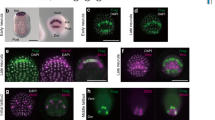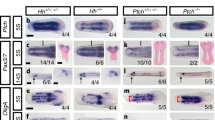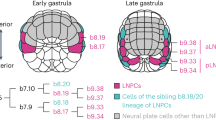Abstract
Three cell types differentiate in the early frog neural plate: neural crest at the lateral edges, floorplate at the midline and primary neurons in three bilateral stripes. Floorplate cells and ventral neurons are induced by Sonic hedgehog1,2 (Shh) and neural crest and dorsal neurons are induced by epidermal factors such as bone morphogenetic proteins (BMPs)3. Neurogenesis in a subset of cells within the stripes involves lateral inhibition4. However, the process by which pools of precursors are defined in stereotypic domains in response to inductive signals is unknown. Here we show that frog Zic2 encodes a zinc-finger transcription factor of the Gli superfamily which is expressed in stripes that alternate with those in which primary neurons differentiate and overlap the domains of floorplate and neural crest progenitors. Zic2 inhibits neurogenesis and induces neural crest differentiation. Conversely, Gli proteins are widely expressed, induce neurogenesis and inhibit neural crest differentiation. Zic2 is therefore a vertebrate pre-pattern gene, encoding anti-neurogenic and crest-inducing functions that counteract the neurogenic but not the floorplate-inducing activity of Gli proteins. We propose that the combined function of Gli/Zic genes responds to inductive signals and induces patterned neural cell differentiation.
This is a preview of subscription content, access via your institution
Access options
Subscribe to this journal
Receive 51 print issues and online access
$199.00 per year
only $3.90 per issue
Buy this article
- Purchase on Springer Link
- Instant access to full article PDF
Prices may be subject to local taxes which are calculated during checkout




Similar content being viewed by others
References
Roelink, H.et al. Floor plate and motor neuron induction by vhh-1, a vertebrate homolog of hedgehog expressed by the notochord. Cell 76, 761–775 (1995).
Ruiz i Altaba, A., Jessell, T. M. & Roelink, H. Restrictions to floor plate induction by hedgehog and winged-helix genes in the neural tube of frog embryos. Mol. Cell. Neurosci. 6, 106–121 (1995).
Liem, K. F. J, Tremml, G., Roelink, H. & Jessell, T. M. Dorsal differentiation of neural plate cells induced by BMP-mediated signals from epidermal ectoderm. Cell 82, 969–979 (1995).
Chitnis, A., Henrique, D., Lewis, J., Ish-Horowicz, D. & Kintner, C. Primary neurogenesis in Xenopus embryos regulated by a homologue of the Drosophila neurogenic gene Delta. Nature 375, 761–766 (1995).
Aruga, J.et al. The mouse Zic gene family, J. Biol. chem. 271, 1043–1047 (1996).
Nagai, T.et al. The expression of the mouse Zic1, Zic2 and Zic3 genes suggests an essential role for Zic genes in body pattern formation. Dev. Biol. 182, 299–313 (1997).
Aruga, J.et al. Anovel zinc finger protein, Zic, is involved in neurogenesis, especially in the cell lineage of cerebellar granule cells. J. Neurochem. 63, 1880–1890 (1994).
Ma, Q., Kintner, C. & Anderson, D. J. Identification of Ngnr1, a vertebrate neuronal determination gene. Cell 87, 43–52 (1996).
Ferreiro, B., Kintner, C., Zimmerman, K., Anderson, D. & Harris, W. A. XASH genes promote neurogenesis in Xenopus embryos. Development 20, 3649–3655 (1994).
Han, K. & Manley, J. L. Functional domains of the Drosophila engrailed protein. EMBO J. 12, 2723–2733 (1993).
Kinzler, K. W. & Vogelstein, B. The Gli gene encodes a nuclear protein which binds specific sequences in the human genome. Mol. Cell. Biol. 10, 634–642 (1990).
Lee, J., Platt, K. A., Censullo, P. & Ruiz i Altaba, A. Gli1 is a target of sonic hedgehog that induces ventral neural tube development. Development 124, 2537–2552 (1997).
Marine, J.-C., Bellefroid, E. J., Pendeville, H., Martial, J. A. & Pieler, T. Arole for Xenopus Gli-type zinc finger proteins in the early embryonic patterning of mesoderm and neuroectoderm. Mech. Dev. 63, 211–225 (1997).
Ruiz i Altaba, A. Cooperation of planar and vertical signals in the induction and patterning of the Xenopus nervous system. Development 115, 67–80 (1992).
Mayor, R., Morgan, R. & Sargent, M. Induction of the prospective neural crest in Xenopus. Development 121, 767–777 (1995).
Essex, L. J., Mayor, R. & Sargent, M. G. Expression of Xenopus Snail in mesoderm and prospective neural fold ectoderm. Dev. Dynam. 198, 108–122 (1993).
Ruiz i Altaba, A. & Théry, C. Involvement of Livertine, a hepatocyte growth factor family member, in neural morphogenesis. Mech. Dev. 60, 207–220 (1996).
Mizuseki, K., Kishi, M., Matsui, M., Nakanishi, S. & Sasai, Y. Xenopus Zic-related-1 and Sox2, two factors induced by chordin, have distinct activities in the initiation of neural induction. Development 125, 579–587 (1998).
Nakata, K., Nagai, T., Aruga, J. & Mikoshiba, K. Xenopus Zic3, a primary regulator both in neural and neural crest development. Proc. Natl Acad. Sci. USA 94, 11980–11985 (1997).
Ruiz i Altaba, A. Catching a Gli-mpse of hedgehog. Cell 90, 193–196 (1997).
Baker, N. E. & Yu, S.-Y. Proneural function of neurogenic genes in the developing Drosophila eye. Curr. Biol. 7, 122–132 (1997).
Ishibashi, M.et al. Targeted disruption of mammalian hairy and Enhancer of split homolog-1 (HES-1) leads to up-regulation of neural helix-loop-helix factors, premature neurogenesis, and severe neural tube defects. Genes Dev. 9, 3136–3148 (1995).
Gans, C. & Northcutt, R. G. Neural crest and the origin of vertebrates: A new head. Science 220, 268–274 (1983).
Acknowledgements
We thank G. Fishell, R. Lehmann, M. Belvin, W. Talbot, N. Dahmane, A. Schier and M. Van Doren for comments; K. Zimmerman for Pax3; Q. Ma and D. Anderson for Ngnr1; D. Turner for the pCS2 series; D. Kessler for pCS2-EnR; D. Melton for NCAM; and J. Aruga and H. Sive for discussion. This work was supported by Skirball Institute start-up funds, a Basil O'Connor Award from the March of Dimes a Pew Fellowship and a grant from the NIH to A.R.A.
Author information
Authors and Affiliations
Corresponding author
Rights and permissions
About this article
Cite this article
Brewster, R., Lee, J. & Altaba, A. Gli/Zic factors pattern the neural plate by defining domains of cell differentiation. Nature 393, 579–583 (1998). https://doi.org/10.1038/31242
Received:
Accepted:
Issue Date:
DOI: https://doi.org/10.1038/31242
Comments
By submitting a comment you agree to abide by our Terms and Community Guidelines. If you find something abusive or that does not comply with our terms or guidelines please flag it as inappropriate.



